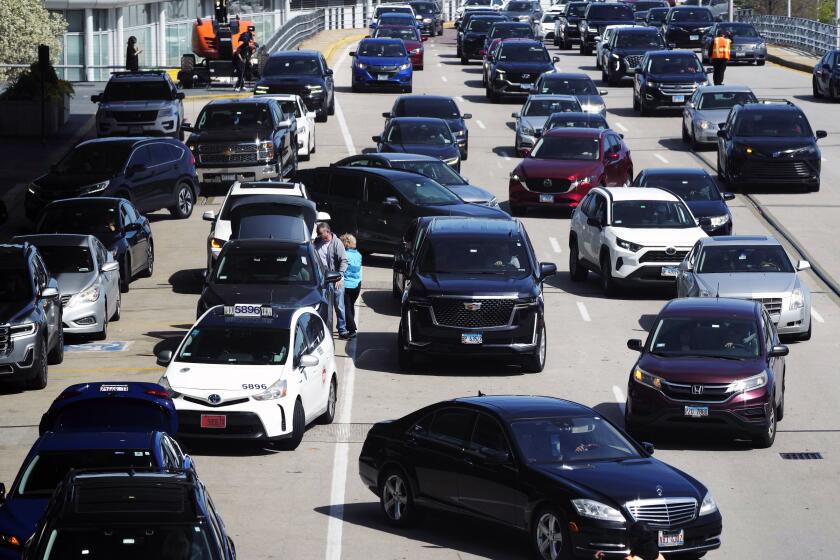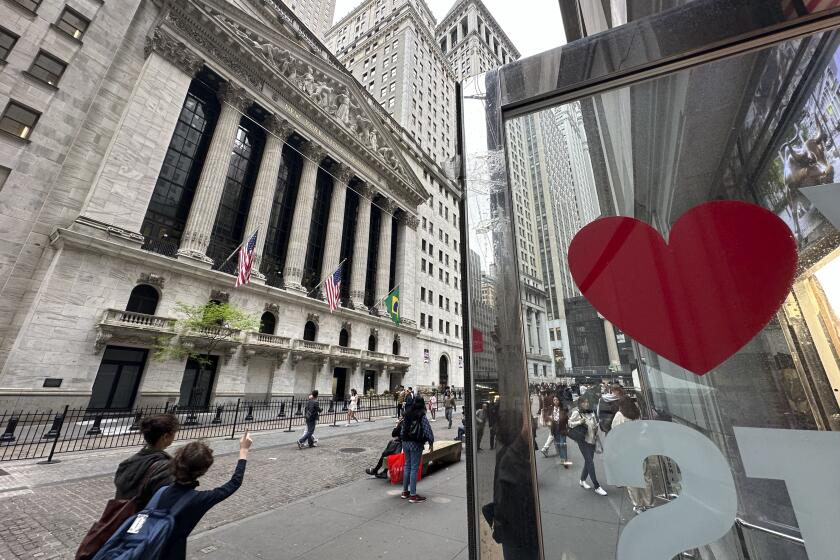Economists See Anemic Upturn After Recession
The much-heralded economic recovery may not be far off, but don’t look forward to a boom: The upturn is expected to be among the most subdued since World War II, in the widely held view of economists.
This consensus--based on lingering problems that affect consumers, businesses and government--represents a belief that there will be a striking change from the experience of other recoveries: In each of the last four decades, hard times have given way to heady times of economic growth.
“The recovery on average is going to be anemic, punky, subpar,” Allen Sinai, chief economist of the Boston Co., an economic consulting firm, declared.
Interest in the recovery is dawning with the first glimmers of light at the end of the slump. On Tuesday, the Conference Board reported a record-breaking leap in confidence among consumers in March, sparking a stock market rally and hopes that the public is getting into a money-spending mood.
People have bought more homes lately, and builders have started breaking ground on additional houses. Cheaper energy prices and lower interest rates further set the stage for a turnaround. As the recession grinds on, by various gauges, many economists now say it could be over this summer; optimists argue it could peter out even sooner.
Yet several traits peculiar to today’s downturn threaten to limit the vitality of tomorrow’s upturn. These problems include debt burdens affecting much of society, shaky government finances, unusually wary lenders and economic woes overseas.
“Everybody’s focusing on consumer confidence,” said Lawrence Chimerine, a private economist and senior adviser to the DRI-McGraw Hill consulting firm. “The problem is, you can’t spend confidence.”
Consumer spending--for homes, cars, refrigerators and everything else--propels two-thirds of the U.S. economy. But consumers do not appear ready for much of a shopping spree, even if the recession ends soon. By some measures, personal income has been falling since late 1989 relative to inflation, reflecting meager wage gains, higher taxes and rising unemployment.
In addition, household debt levels remain extraordinarily high, largely due to homes purchased in the 1980s. Although the growth of household debt has been slowing, the debt is huge--almost equaling overall disposable income, according to government statistics. Savings remain low.
“This will be the weakest consumer contribution to a recovery in the history of the post-World War II economy,” Stephen S. Roach, a senior economist with the Morgan Stanley investment firm in New York, predicts.
Sound grim? Economics hasn’t been dubbed the dismal science for nothing, and some experts say the consensus view is too gloomy. Moreover, slower growth is not entirely bad. A lukewarm recovery would tend to safeguard the nation from the boom-and-bust pattern of rising inflation that leads to higher interest rates and, ultimately, another downturn.
Subdued consumer spending also has favorable implications for the trade deficit: America’s import bill would be smaller in a modest recovery than in a heated one, helping to narrow its trade gap with other nations.
“We won’t see inflation come roaring back,” said Mark M. Zandi, an economist at Regional Financial Associates in West Chester, Pa. “The economy will be more stable and grow at a more even pace.”
Still, predictions of a tepid recovery aren’t the sort of thing that brings euphoria into executive suites.
At the Maytag Corp.--a maker of washing machines, refrigerators, gas ranges, vacuum cleaners and other consumer products--reports of rising consumer confidence have been duly noted. Good news is welcome at the Iowa-based firm: The recession has caused layoffs, a salary freeze and production cutbacks.
Yet, executives worry that financial pressures on the public could affect business long after the glow of victory in the Persian Gulf War fades.
“I think that some of the basic problems that were there before last August are still there,” said Leonard A. Hadley, president of the firm, which manufactures Maytag, Admiral, Hoover and Magic Chef products. He added: “I think it will be a sluggish recovery.”
Strapped consumers aren’t the only cause for modest expectations. Compared to other recessions, today’s episode has been relatively mild in much of the nation, a factor that could limit the “snap-back” of recovery.
The overall economic decline is expected to be in the range of 2.5% to 3%, according to many forecasters, with some putting it as low as 1.9%. By contrast, the U.S. economy tumbled by 3.2% in the recession of 1981-1982 and 4.3% in the slump of 1973-75.
Having slipped less this time, the economy has less ground to recover. The nation’s factories, for instance, are running at 79% of capacity. Although that rate could slip a bit further, it appears that it will remain substantially higher than in the last recession, when factory rates dipped below 70%.
“The 1981-1982 recession left us with more slack in the economy” and, therefore, more room for a robust recovery, Sinai observed.
A broad pattern of financial weakness among state and local governments poses further uncertainties. By some estimates, the fiscal problems could lead to $25 billion in tax increases this year alone, along with cuts in services and payrolls in many places.
Last year, 10 states approved measures designed to hike their tax revenue by at least 5%, and several others imposed smaller increases, according to the National Conference of State Legislatures. In California--which faces a potential budget shortfall of up to $10 billion over the next 15 months--state officials are considering a new tax on a variety of personal and professional services.
Throughout the country, growing tax burdens could chip away at people’s spending power: Higher tax payments leave less income to buy VCRs and microwave ovens. The tax hikes, combined with cuts in government payrolls, could take half a percentage point off growth in the next year, Zandi said.
The state financial troubles, he warned, “are going to play an important role in reducing economic activity after the recession is over.”
Financial questions don’t end there. Analysts worry that the “credit crunch”--in which banks and thrifts have become more cautious because of existing loan problems and pressure from regulators--could linger and reduce future economic activity.
Meanwhile, new troubles are emerging among America’s trading partners. Canada and the United Kingdom are currently in slumps, and Japan and Germany face economic problems of their own, just when it appears that America may be heading back toward a growth track. Separately, a rise in the dollar’s value could make it harder for U.S. producers to compete in price with their foreign rivals.
Combined, these problems could take some of the pizazz out of U.S. exports, which are viewed as an important engine of recovery.
“We can’t count on exports quite as strongly as we normally would,” said Robert J. Eggert, an economist in Sedona, Ariz. The Blue Chip consensus report of 51 forecasters, published by Eggert, recently suggested that the U.S. economy would grow at a 2.6% rate from mid-1991 to mid-1992--less than half the growth level of past recoveries.
Even those who agree with the subdued outlook acknowledge that the economy has a way of catching forecasters off guard. Consumers, for example, may have a larger appetite for cars and other purchases than the experts calculate. In addition, the Federal Reserve Board is trying to offset the credit pinch through policies designed to encourage lending and borrowing.
“While the arguments for a weak recovery appear compelling, it is not impossible to imagine” a somewhat stronger level of growth, David D. Hale, an economist at Kemper Financial Services in Chicago, contends.
At the Levitz Furniture Corp., executives are poised for a “fairly dramatic” rebound in sales, which have slumped throughout the furniture industry since mid-1989. Indeed, the recovery after the 1981-82 downturn made a lasting impression: Sales zoomed 29% once the economy got back on its feet.
But, despite the fond expectations, the Boca Raton, Fla.-based retailer, which has 118 stores, believes that credit card and mortgage debt could put a damper on consumer spending when the current recession winds down.
“For planning purposes, we’re staying relatively conservative,” said Patrick J. Nolan, Levitz’s senior vice president and treasurer.
BRISK RECOVERIES
Recessions have usually been followed by periods of robust economic growth. The next recovery may be an exception.
Economic growth during: Economic first year of second year of Recession decline recovery recovery 1953-54 -2.6 % 6.0 % 2.5 % 1957-58 -3.0 8.1 1.8 1960-61 -1.0 6.1 3.1 1969-70 -0.4 3.2 7.2 1973-75 -4.3 6.1 3.3 1981-82 -3.2 6.5 5.1 Average -2.4 6.0 3.8 1990-91* -1.9 4.0 --
* forecast
Source: Morgan Stanley estimates based on U.S. Department of Commerce statistics






